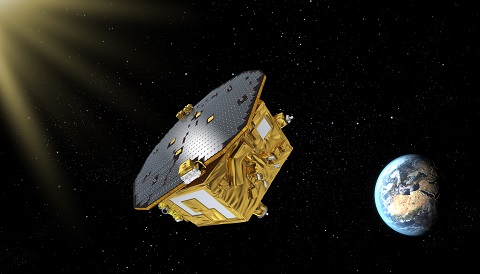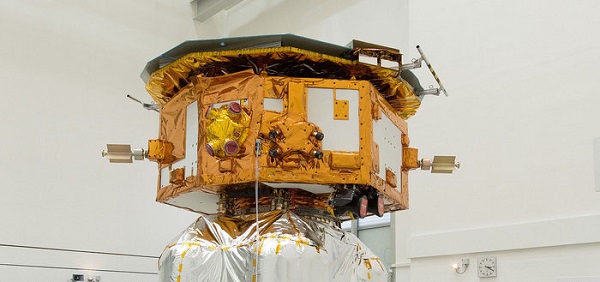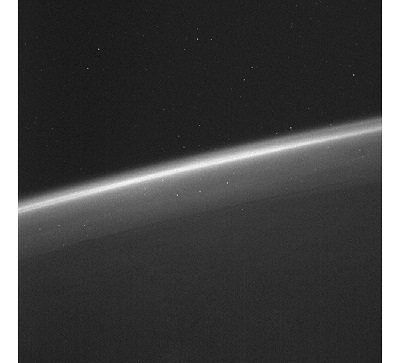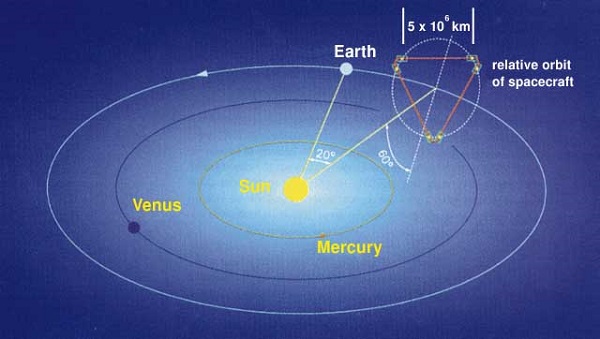The European Space Agency switched off its groundbreaking LISA Pathfinder mission this week.

ESA/C.Carreau
A pioneering mission came to a quiet end earlier this week, as the European Space Agency's LISA Pathfinder finished its mission. Controllers at the European Space Operations Centre in Darmstadt, Germany, sent the final commands to the spacecraft shortly after 20:00 Central European Time on Tuesday, July 18th.
"When we were in contact with LISA Pathfinder yesterday evening for the last time and said goodbye to the satellite, it was a unique and emotional moment," says Karsten Danzmann (Max Planck Institute for Gravitational Physics, Germany) in a recent press release. "After years of planning, we have been spending many days and nights since early 2016 paving the way for the future of gravitational-wave astronomy with LISA Pathfinder."
Launched on December 3, 2015, just before the announcement of the first direct detection of the ripples in spacetime known as gravitational waves, LISA Pathfinder was a technology demonstrator for the upcoming Laser Interferometer Space Antenna (LISA) mission. LISA will listen for low-frequency gravitational waves, such as those generated by merging supermassive black holes.
LISA Pathfinder performed its mission from a lissajous, or halo, orbit around the L1 Lagrange point, 1.5 million kilometers sunward of Earth. This gravitationally quiet environment allowed LISA Pathfinder to keep two 44-millimeter-diameter, gold-platinum cubes in free fall for an extended period of time, separated from each other by a distance of 38 cm.
Designed not to detect gravitational waves but rather serve as a technology test bed, LISA Pathfinder met its key technology criterion in June 2016. In fact, ESA scientists announced then, LISA Pathfinder was actually five times more sensitive than required.

ESA/P. Sebirot
ESA also managed to get some extra science out of the mission. For example, LISA Pathfinder was used to sample the local micrometeoroid environment by detecting impacts on the spacecraft. Though the mission concluded on June 30, 2017, engineers continued to stress test the spacecraft, working out the thrusters and studying the effects of magnetic interference and solar illumination, known as “baking out” the instruments.

Airbus-DS / ESA / LPF
Though it was a non-imaging mission, the star-trackers did snap a few images of the Earth on the way to the L1 point as well.
The full-up LISA mission will have a long road to space. In 2011 NASA pulled out of its partnership with ESA due to budget constraints. The mission was later reborn under the ESA as ELISA (Evolved LISA). NASA is currently reviewing options to participate in the ELISA program. The mission has a planned launch date of 2034.
A New Era of Gravitational Wave Astronomy
The future LISA mission will feature three spacecraft flying in a triangular formation, each 2.5 million km apart from its partners, trailing 50 million km behind the Earth in a heliocentric orbit. In this formation, it will probe lower frequencies that inaccessible to its ground-based counterpart, LIGO.

NASA / GSFC
In addition to listening for the mergers of supermassive black holes and learning more about their formation, LISA will also test the fundamental principles of gravity as we currently understand it. For now, though, LISA Pathfinder will continue to silently circle the Sun for hundreds if not thousands of years in its stable orbit, a small stepping stone in the new era of astronomy.
 2
2









Comments
Graham-Wolf
July 24, 2017 at 12:45 am
Well done, LISA.
You have performed well beyond original expectations.
You have again, shown the true value in international space collaborations.
We Earthlings proudly salute you!
Graham W. Wolf at Dunedin:- NZ.
You must be logged in to post a comment.
Esnuka
July 28, 2017 at 6:41 pm
LISA experiment will search for gravitational waves but it will also be equivalent to Michelson-Morley experiment. LISA results will be different, they will closer to classics expectations.
http://www.molwick.com/en/relativity/004-michelsonmorley.html
http://www.molwick.com/es/relatividad/r-experimento-michelson-morley-eter.gif
You must be logged in to post a comment.
You must be logged in to post a comment.